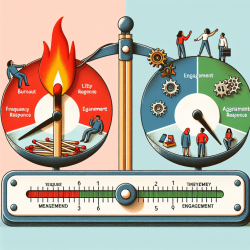Introduction
In the realm of occupational and organizational psychology, the measurement of burnout and engagement is crucial. These constructs are dynamic and complex, influencing various populations, including workers, social workers, and students. A recent study published in the International Journal of Environmental Research and Public Health compares frequency-based and agreement-based response formats for measuring these phenomena. The findings suggest that frequency-based measurements provide a more accurate depiction of the dynamic nature of burnout and engagement.
Understanding the Research
The study conducted by Tong, Bickmeier, and Rogelberg (2020) involved two samples: employees from multiple organizations and employees from a single company. The research aimed to determine which response format better captures the dynamic states of burnout and engagement. The results showed that frequency-based response formats outperformed agreement-based formats in explaining the variance in outcome variables related to burnout and engagement.
Why Frequency-Based Formats Are Superior
Frequency-based response formats, which assess how often a behavior or symptom occurs, provide a more nuanced understanding of burnout and engagement. These formats capture the dynamic fluctuations of these states more effectively than agreement-based formats, which measure the intensity of agreement with a given statement. Agreement-based formats can be vague and subjective, leading to inconsistent interpretations.
Implications for Practitioners
For practitioners, especially those involved in online therapy services like TinyEYE, these findings are significant. Implementing frequency-based response formats in assessments can lead to more accurate diagnoses and better-targeted interventions. This approach allows practitioners to monitor changes in burnout and engagement over time, facilitating more effective treatment plans.
Encouraging Further Research
While this study provides valuable insights, it also opens the door for further research. Future studies could explore the impact of different time frames on the effectiveness of response formats or investigate other dynamic constructs. By continuing to refine measurement techniques, we can enhance our understanding and treatment of burnout and engagement.
Conclusion
In conclusion, the research highlights the superiority of frequency-based response formats in measuring burnout and engagement. For practitioners, adopting these formats can improve the accuracy of assessments and the effectiveness of interventions. As we continue to explore these dynamic constructs, ongoing research will be essential in advancing our knowledge and practice.
To read the original research paper, please follow this link: A Comparison of Frequency- and Agreement-Based Response Formats in the Measurement of Burnout and Engagement.










